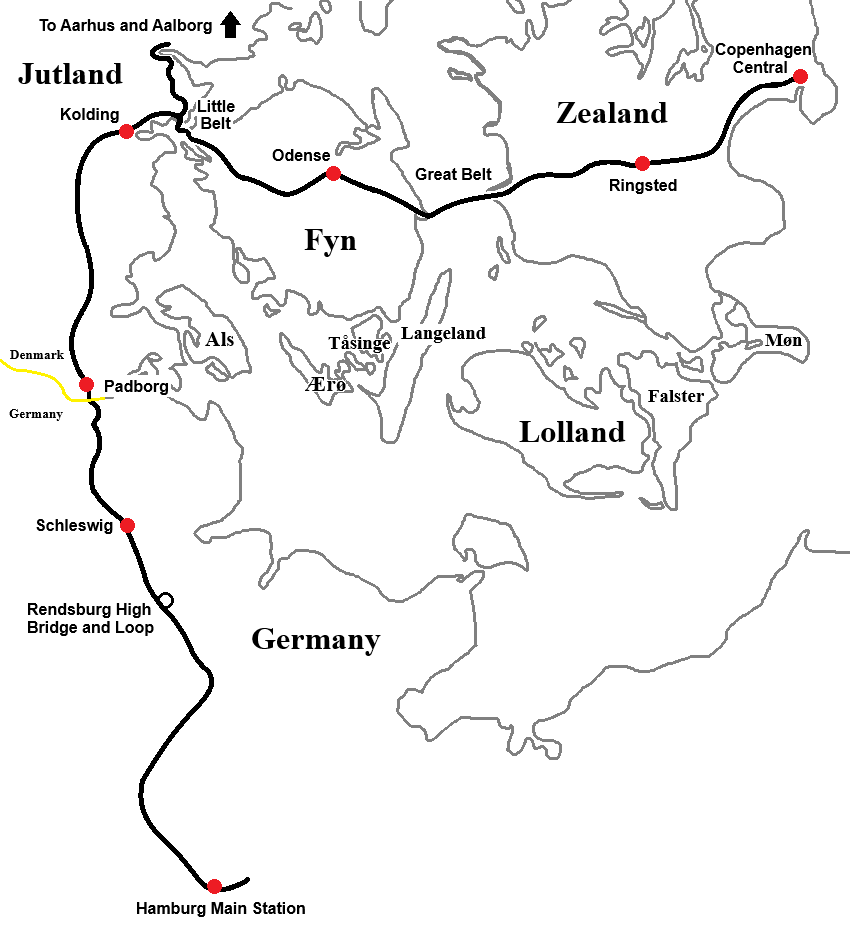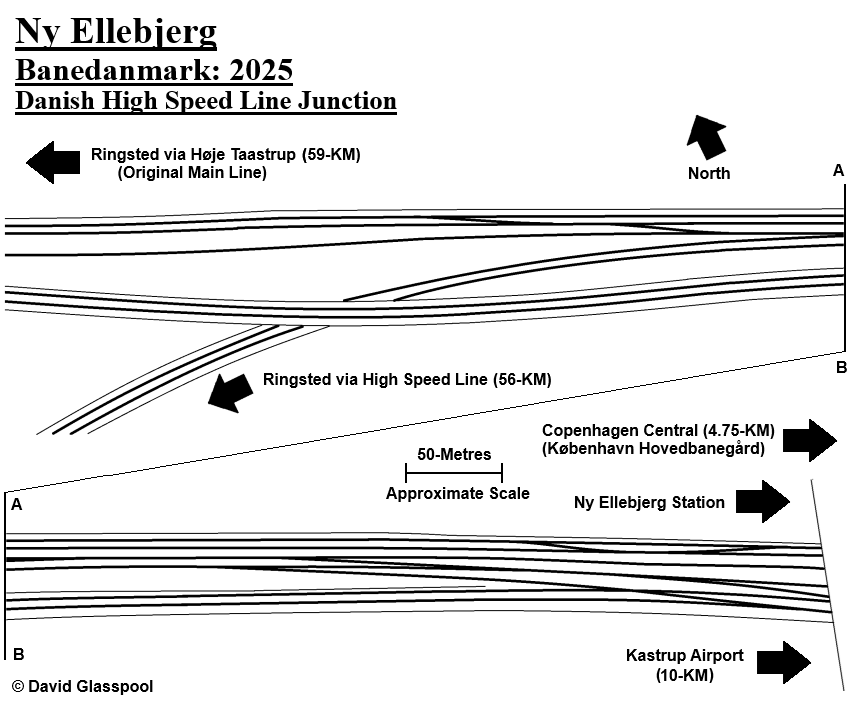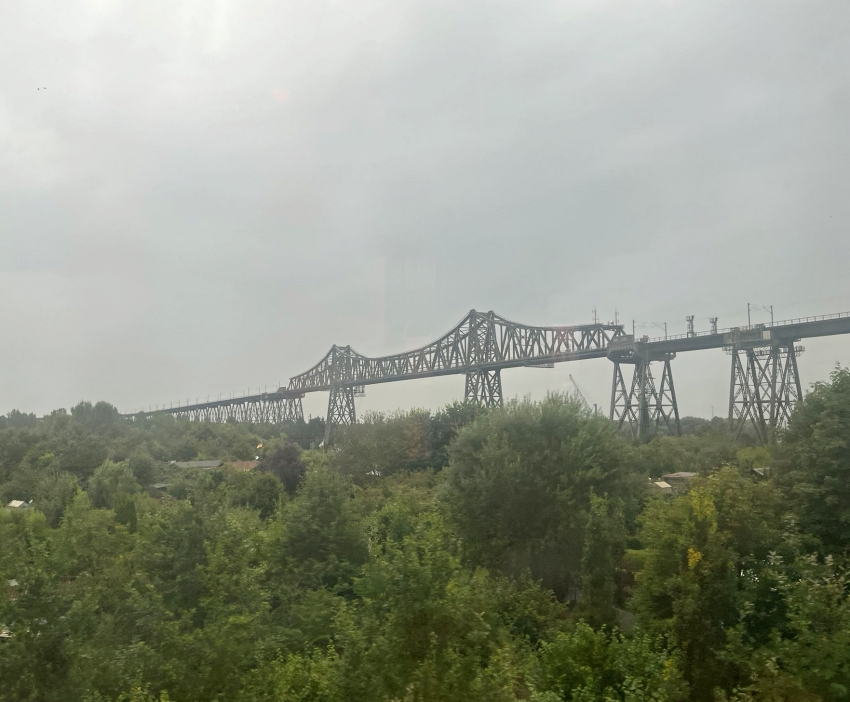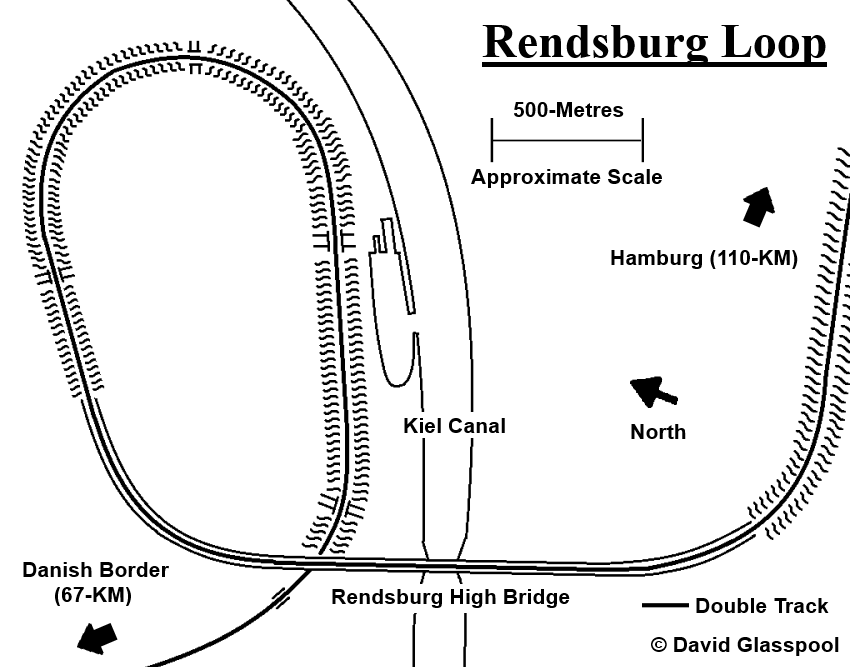Copenhagen to Hamburg
My wife and I spent the last weekend of August 2025 in Copenhagen, Denmark.
The outward trip involved flying out from London Stansted on the Saturday morning; however, for the return journey to London, we planned to go all the way by rail. This was scheduled to take place over three days:
- 1st September: Copenhagen Central to Hamburg.
- 2nd September: Hamburg to Amsterdam Centraal, with a change of trains at Osnabruck.
- 3rd September: Amsterdam Centraal to London St Pancras International by Eurostar.
This page looks at the Copenhagen Central to Hamburg portion of the journey, timetabled for a duration of 4-hours 38-minutes over 505-KM of route.
Train Route

1st September 2025
The departure to Hamburg was scheduled for 10:22 from Copenhagen Central's platform 5. This is a north westward view from that platform underneath the cavernous train shed, which covers twelve tracks and an equal number of platform faces, the latter formed into six islands. A thirteenth platform face exists south east of the trainshed, on the opposite side of the road bridge that is just visible in the next photograph. In the September 1898 edition of "The Railway Magazine", it was remarked: "Copenhagen, unfortunately, has not a station worthy of the capital". Subsequently, in 1903, work began on constructing a new main station for the city, which was designed by Professor H. Wenck, Chief Architect for new construction to Danish State Railways (ref: Locomotive, Railway Carriage and Wagon Review, 15th October 1924). Opened in 1911, the level of the rails at the station was made 6.25-metres below street level; above the tracks and perpendicular to them, a main hall of 138-metre length by 56-metre width was created, which was covered by a twin-span roof of timber construction supported upon stone columns (ref: Locomotive, Railway Carriage and Wagon Review, 15th October 1924). © David Glasspool
1st September 2025
The Hamburg service starts at Copenhagen. This view, looking in the opposite direction to the previous one, shows the carriages for Hamburg arriving from the sidings located south west of the station, being reversed into platform 5 by Siemens "Vectron" No. EB 3203. On 14th September 2020, the first three (of which No. 3203 was one) of forty-two "Vectron" electric locomotives ordered by Danish State Railways (DSB) arrived in Denmark, and on 26th of the following month the type entered regular passenger service (ref: DSB Interim Report, Third Quarter 2020). Since 17th June 2023, DSB has used "Vectron" locomotives on the Copenhagen to Hamburg route with a fleet of fifty-six IC1 carriages — one captured here — the latter of which are leased from Deutsche-Bahn (DB) (ref: DSB Annual Report, 2023). The advent of this stock combination released the incumbent IC3 units from the service, the latter being deployed on other lines such as that between Aarhus and Hamburg (ref: DSB Annual Report, 2023). © David Glasspool
1st September 2025
Most of the Second Class accommodation comprises open seating in a 2+2 formation: a mixture of "airline" style and four seats facing each other around a table. The carriage immediately behind the locomotive contained a couple of Second Class compartments of six seats each, the pair nearest the window sharing a table. Departure from Copenhagen was just one minute behind schedule, at 10:23. © David Glasspool

1st September 2025
The first stop from Copenhagen is Ringsted, thirty minutes into the journey. Between Copenhagen and Ringsted, the Hamburg service uses the 60-KM double-track electrified high-speed line that officially opened on Friday, 31st May 2019, upon which the train travels at speeds of up to 200 KPH (ref: Copenhagen to Ringsted, Projects, Banedanmark, 2019). The station at Ringsted is situated upon the original main line that links Copenhagen with the rest of Denmark, via Høje Taastrup, and this view is looking back in the direction of the capital. © David Glasspool
1st September 2025
After Ringsted is a 96-KM run to Odense, the latter situated on the island of Fyn. The islands of Zealand (upon which is Copenhagen) and Fyn are separated by a body of water called the "Great Belt", and in 1988 work began on an enormous project to connect the two by road and railway. Today, this is known as the "Storebælt (Great Belt) Crossing", which comprises the 8,024 metre-long "East Tunnel" for railway traffic, the 6,790 metre-long "East Bridge" for road traffic, and the 6,611-metre-long West Bridge for both cars and trains. The tunnel and East and West Bridges all meet on the uninhabited island of Sprogø, in the middle of the crossing, which grew four times its original size as part of the construction works. The crossing officially opened to railway traffic on 1st June 1997 and to road vehicles on 14th June of the following year, the project having cost DKK 21.4 billion at 1988 prices (ref: Storebaelt Facts and History, storebaelt.dk). In the above photograph looking in the Copenhagen direction from Fyn, just after the train had completed the crossing, the pylons and cables of East Bridge can be seen in the distance. In the foreground is the low-level West Bridge, which carries road and railway side-by-side. © David Glasspool
1st September 2025
Odense, the principal town on Fyn, was reached on time, with a subsequent departure a minute ahead of schedule. Today's station was opened in 1995 (ref: Jerbanen, The Journal of the Danish Railway Club, December 1995 to February 1996), comprising six platform faces serving an equal number of tracks, five of which pass through, the sixth terminating. Odense is home to Denmark's Railway Museum, just visible in the background of this eastward view, which opened on 17th April 1975 (ref: Danmarks Jernbanemuseum) and is situated within a semi-roundhouse. © David Glasspool
1st September 2025
The mainland of Jutland is reached from Fyn by crossing the "Lillebælt" (Little Belt). The road and railway share the same crossing, upon a girder bridge, which was opened by King Christian of Denmark on 14th May 1935 and replaced one of two ferries (ref: The Railway Magazine, July 1935). Construction of the bridge, which carries two sets of rails and a road, was approved in 1927 at an original cost of 18.5 million DKK, although taking into account associated works such as road realignment and connections, the estimated amount was 40 million DKK (ref: The Railway Magazine, July 1935). This eastward view from the train captures, on the left, the suspension bridge carrying a second road crossing of six lanes over the Lillebælt, which opened on 21st October 1970 (ref: visitfredericia.com). © David Glasspool
1st September 2025
Kolding is the penultimate stop in Denmark for the Hamburg service before the train crosses the border into Germany. The town is positioned at the head of an arm of the Little Belt called the "Kolding Fjord" and was once an important centre for textiles and hardware (ref: The Railway Magazine, October 1951). The Fredericia to Vamdrup section of line, upon which Kolding is situated, came into use on 1st November 1866 (ref: L'Union postale, Volumes 38-39, Bureau International de l'Union Postal Universelle, 1913). © David Glasspool
1st September 2025
The ends of the platforms at Padborg, the train's final stop in Denmark, are positioned little over half a kilometre from the German border. The site is equipped with an extensive array of sidings, unsurprising given it is a border station — there even still exists a turntable here. By the time Padborg was reached, there were passengers camped out on the floor in the vestibule, so it was not possible to get a picture out of the carriage door looking back towards the station. Seen here are the southern ends of the sidings that exist on the eastern side of the station. In view is a Plasser & Theurer 09-32/4S tamper, belonging to construction firm "Swietelsky". Tamper machines are used to correct track alignment errors and consolidate ballast to provide stable support. After measuring the position of the rails, a tamper can lift the track — complete with sleepers attached — using a series of hydraulic cylinders to remove kinks and smooth out dips. © David Glasspool
1st September 2025

The first stop in Germany is Schleswig, 41-KM from Padborg. 30-KM from Schleswig, the railway crosses the Kiel Canal on the huge Rendsburg High Bridge. This picture was taken from the train when it was upon the "Rendsburg Loop", which is a circular section of railway that climbs to the height of the double-track steel bridge. © David Glasspool

1st September 2025
Rendsburg High Bridge carries trains 138-feet (42-metres) above water level (ref: The Railway Magazine, September and October 1949). This is a roughly westward view which includes, on the right bank of the canal, the buildings of agricultural group "Ceravis AG" and logistics firm "HaGe". © David Glasspool
1st September 2025
About 7-KM north west of Hamburg Main Station, in the borough of Eidelstedt, are colossal rolling stock sidings that flank the western side of the running lines. As our journey from Copenhagen nears its end we see, in the foreground, a Siemens ICE (InterCity Express) 4 high-speed unit, part of that company's "Velaro" fleet and a variation of the same family of trains as the e320 series used by Eurostar. In the background is an ICE 1 formation, the type of which was introduced in 1991. © David Glasspool
1st September 2025
South of the sidings at Eidelstedt are a series of triangular junctions where routes to Hamburg Main Station (the destination of our train) and the terminus of Hamburg-Altona diverge. The latter resides about 4.6-KM west of the former as the crow flies, or about 6.2-route-KM, in Hamburg's most western district of Altona. A series of long-distance trains start/finish at Altona, whilst serving the Main Station en route; one such example is here, where the rear of an ICE 4 unit is seen heading away from the camera towards the city's western terminus. The single-track viaduct seen here allows trains from the Main Station direction to access the terminus at Altona. Hamburg Main Station is in the direction to the left of this photograph. © David Glasspool
1st September 2025
We've made it, arriving at 15:06, just six minutes behind schedule and a total journey duration of 4-hours 44-minutes. Siemens "Vectron" No. 3203 had pulled the train throughout from Copenhagen, arriving at Hamburg Main Station's platform 5. © David Glasspool
1st September 2025
The cavernous Hamburg Main Station was opened in December 1906 at a cost of £4,250,000 (ref: Nottingham Evening Post, 6th December 1906). This northward view includes the carriages of the service from Copenhagen on the far right. © David Glasspool
Return to the Kent Rail Homepage or alternatively, check for Updates.
Website & Copyright information - Links - Contact the Webmaster
